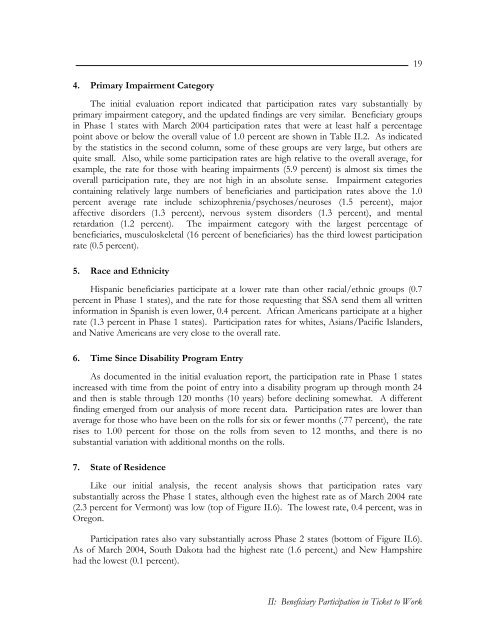Evaluation of the Ticket to Work Program, Implementation ...
Evaluation of the Ticket to Work Program, Implementation ...
Evaluation of the Ticket to Work Program, Implementation ...
You also want an ePaper? Increase the reach of your titles
YUMPU automatically turns print PDFs into web optimized ePapers that Google loves.
194. Primary Impairment CategoryThe initial evaluation report indicated that participation rates vary substantially byprimary impairment category, and <strong>the</strong> updated findings are very similar. Beneficiary groupsin Phase 1 states with March 2004 participation rates that were at least half a percentagepoint above or below <strong>the</strong> overall value <strong>of</strong> 1.0 percent are shown in Table II.2. As indicatedby <strong>the</strong> statistics in <strong>the</strong> second column, some <strong>of</strong> <strong>the</strong>se groups are very large, but o<strong>the</strong>rs arequite small. Also, while some participation rates are high relative <strong>to</strong> <strong>the</strong> overall average, forexample, <strong>the</strong> rate for those with hearing impairments (5.9 percent) is almost six times <strong>the</strong>overall participation rate, <strong>the</strong>y are not high in an absolute sense. Impairment categoriescontaining relatively large numbers <strong>of</strong> beneficiaries and participation rates above <strong>the</strong> 1.0percent average rate include schizophrenia/psychoses/neuroses (1.5 percent), majoraffective disorders (1.3 percent), nervous system disorders (1.3 percent), and mentalretardation (1.2 percent). The impairment category with <strong>the</strong> largest percentage <strong>of</strong>beneficiaries, musculoskeletal (16 percent <strong>of</strong> beneficiaries) has <strong>the</strong> third lowest participationrate (0.5 percent).5. Race and EthnicityHispanic beneficiaries participate at a lower rate than o<strong>the</strong>r racial/ethnic groups (0.7percent in Phase 1 states), and <strong>the</strong> rate for those requesting that SSA send <strong>the</strong>m all writteninformation in Spanish is even lower, 0.4 percent. African Americans participate at a higherrate (1.3 percent in Phase 1 states). Participation rates for whites, Asians/Pacific Islanders,and Native Americans are very close <strong>to</strong> <strong>the</strong> overall rate.6. Time Since Disability <strong>Program</strong> EntryAs documented in <strong>the</strong> initial evaluation report, <strong>the</strong> participation rate in Phase 1 statesincreased with time from <strong>the</strong> point <strong>of</strong> entry in<strong>to</strong> a disability program up through month 24and <strong>the</strong>n is stable through 120 months (10 years) before declining somewhat. A differentfinding emerged from our analysis <strong>of</strong> more recent data. Participation rates are lower thanaverage for those who have been on <strong>the</strong> rolls for six or fewer months (.77 percent), <strong>the</strong> raterises <strong>to</strong> 1.00 percent for those on <strong>the</strong> rolls from seven <strong>to</strong> 12 months, and <strong>the</strong>re is nosubstantial variation with additional months on <strong>the</strong> rolls.7. State <strong>of</strong> ResidenceLike our initial analysis, <strong>the</strong> recent analysis shows that participation rates varysubstantially across <strong>the</strong> Phase 1 states, although even <strong>the</strong> highest rate as <strong>of</strong> March 2004 rate(2.3 percent for Vermont) was low (<strong>to</strong>p <strong>of</strong> Figure II.6). The lowest rate, 0.4 percent, was inOregon.Participation rates also vary substantially across Phase 2 states (bot<strong>to</strong>m <strong>of</strong> Figure II.6).As <strong>of</strong> March 2004, South Dakota had <strong>the</strong> highest rate (1.6 percent,) and New Hampshirehad <strong>the</strong> lowest (0.1 percent).II: Beneficiary Participation in <strong>Ticket</strong> <strong>to</strong> <strong>Work</strong>
















